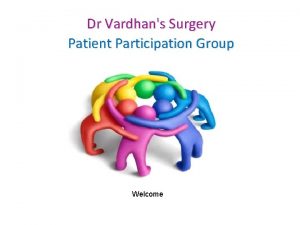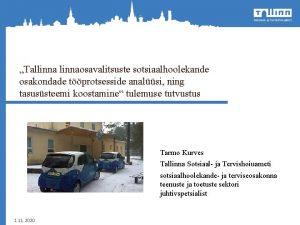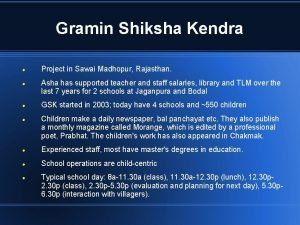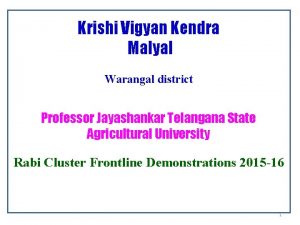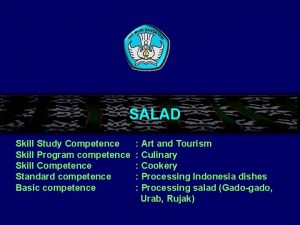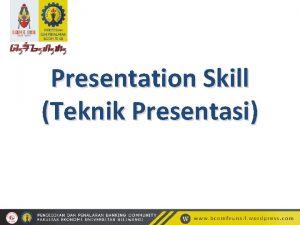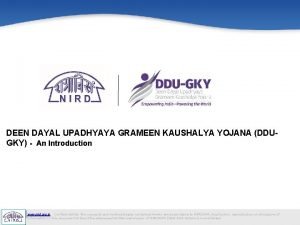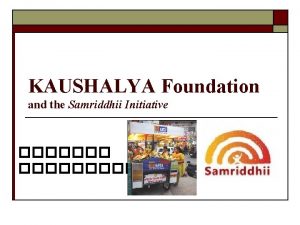Presentation on Kaushalya Vardhan Kendra Skill development Project















- Slides: 15

Presentation on Kaushalya Vardhan Kendra (Skill development ) Project of Gujarat Date – 27 th August 2014 Presentation by – V. S. Champavat Directorate of Employment & Training Government of Gujarat 1

Background • India enjoys benefits of demographic dividend. 35% of population of India is below 15 years age and 700 million people are below 35 years of age* • Indian economy emerged a robust and consistent performer during recent recessions. • National Skill Development Corporation aims to provide 500 million skilled manpower by 2022 -Gujarat needs to skill 4 million youth, around 5 lakhs / year+. • To meet the demand of Skilled Man Power and provide employment opportunities to address rural population that constitutes 70%. • To harness the potential of rural youth. • Impart Training of Hard and Soft Skills to meet the demand of regional and local industries. • Increase employability through certification. * Source: Census-2011 +Source: NSDC website Organization profile 2

What is Kaushalya Vardhan Kendra ? • An Institute to Impart desired skill training at the door steps of the rural population • Courses designed on the basis of participatory approach of Kaushalya Sabha in the villages with population of 5, 000 in general and 4, 900 in tribal areas Ø Now in villages having population of 2500 to cover all tribal talukas 3

Purpose and Priorities of KVK Initiative “KVKs are one of such unique initiatives created in the state of Gujarat to fulfill the skill needs of the industries in various sectors and simultaneously catering to local requisites thereby ensuring social welfare. ” • Instead of trainees going to the institutes, the institutes come to the trainees • Rehabilitate school drop outs, skill & empower the rural youth, adolescent girls and housewives • Flexible approach: Instead of trainees being offered available courses, the institutes run courses preferred by trainees and industry • To support the supply of trained skilled persons who are adjustable dynamically to the changing demands of employment and technologies • Promote self-employment and entrepreneurship by multi skilling • Improve employability and thereby reduce poverty 4

Strategies adopted to bring transformation Lead to… Identification of Location for KVK Selection of Courses Identification of trainers Course duration, timings, soft skill requirement etc. • Adopted WISH approach W - Women Oriented Courses I - Industry Specific Courses S- Soft Skill Related Courses H- Hard Core Traditional Courses 5

Roadmap 2012 15 th August 2010 Total 500 KVKs 2011 2014 June-July 2010 Additional 35 KVKs Additional 165 KVKs Establishment of additional 150 KVKs Apr – June 2010 Inauguration of 150 KVKs March 2010 3 -7 th Dec 2009 Identifying school , rent-free buildings. Kaushalya Sabhas , interaction with stakeholders Earmarking of Budget Chintan Shibir at Dhordo (Conceptualizing KVK) 6

Highlights of the Initiative Achievement • 11, 98, 634 youth trained out of which 7, 47, 181 are women (62%) from August -2010 till July-2014. • Total - 500 KVKs. Training Modality • Minimum 4 courses @ 20 trainees / each courses (Compassing soft skill training • Fee assumption for SC/ST/Women/PH & BPL candidates and nominal fees of Rs. 50/- for General Candidates • No upper age limit • Admission on the bases of Oral Test for the candidates having no school leaving certificate • 512 Short term courses have been identified considering local need (40 hrs. to 576 hrs). • 1980 Life Skill courses also have been identified • Certification by Gujarat Council of Vocational Training (GCVT) 7 Budget (Per KVKs)

Monitoring Mechanism of KVK • NIC developed portal for KVK monitoring • Principal of attached ITI designated as Skill Development Officer (SDO) • Created post of Co-ordinator (Foreman Instructor) to Head the KVK • Kaushalya Sabha in villages for awareness generation regarding benefits of KVK, identification of courses, liaison with Kaushalya Samitis • Constituted Kaushalya Samitis to ensure proper infrastructure facilities for training, quality of training, awareness campaign, linkage with industry for promoting employment and self-employment • Regular Meetings of all Co-ordinators at Head Office & RDD office • Usage of SATCOM for review at Kaushalya Samitis Level 8

Role of key stakeholders Labour & Employment Department Directorate of Employment &Training Skill Development Officer-SDO (Principal of mentor ITI) Coordinator of the respective KVKs (Regular Foreman Instructor) Kaushalya Samiti at village level Village & Block Leaders Framing Policies & norms, Providing adequate budget Overall Implementation, Monitoring & Supervision Coordination with cluster villages, Monthly inspection & evaluation, fund disbursement & skill gap analysis Head of the unit & member secretary of Kaushalya Samiti - Selection of courses, training activities, admission, examination & placement assistance. Sensitize local youth, assess the local needs, evaluate quality of training & social audit. To guide people to avail benifits 9

Outcome of the Initiative Number of Trainees Trained (Progressive) 1400000 1200000 1198634 1099592 1000000 800000 679074 600000 482334 364091 400000 200000 747181 807699 116565 209178 55372 0 Year 2010 -11 Year 2011 -12 Progressive Trainees Trained Year 2012 -13 Year 2013 -14 Year 2014 -15 (Up to July-2014) No. of Women (Progressive) • Percentage of women participants increased from 47% (2010 -11) to 62% (up to July -2014) in 2014 -15. • KVK has given impetus to a new form of training culture among the rural folks specially women Popular Courses 10

i-KVK (Industrial Kaushalya Vardhan Kendra) Under the Chairmanship of then Hon'ble Chief Minister Shri Narendrabhai Modi, the following schemes were launched during the "Shram Kaushalya Pancham Samaroh" on February 24, 2014 Vision Mission Statement The theory runs that companies will be willing to pay only for those skills that are strictly firmspecific, i. e. , much more useful for them than for other companies – high degree of engagement and ownership on the part of the employer Skilling in the Industry by the Industry for the Industry and beyond on Specific Courses with Certification from the Government rs he Ot ic m ra ile xt Te a m ar Ph g 50 8 Ce ► 16 10 En g ► l ► 17 7 ica ► em ► Intas, Zydus Cadilla, Cera Sanitary, Bhagwati Sphero Cast, Vatva Industries Association, Narayan Hosp. , Plumbing Association, etc. 75 80 70 60 50 40 30 20 10 0 Ch ► To generate “In house” skills to meet up Standardized Benchmarks ► To increase employability ► To produce an industry-ready workforce ► Win-Win Scenario for 3 Stakeholders i. e. Government, Industries & Workers ► Sector wise Industries to Fact File ► Trainees to be trained at the industry training centre Provision of industry based theory and practical assignments by the sector/ industry experts will eventually reduce the existing skill mismatch, thereby bringing down the skill gap Decentralized approval of syllabus (within 48 Hrs) – Setting norms Industry specific Assessment & Certification by GCVT/ MES Memorandum of Association (Mo. A) signed for 125 i-KVK Centres 22 Sectors have been covered under the scheme As many as 136 courses (Long Term : 24, Short Term : 112) have been identified Operationalized web portal for I-KVK, Au ► Objectives 11

Laurels and Achievements 1. Ownership of the project is vested with stakeholders 2. After intense review of the scheme, Planning Commission & Ministry of Labour, Go. I has felt that Kaushalya Vardhan Kendra model implemented by Government of Gujarat appears to be appropriate for designing PPP architecture for setting up 5000 Skill Development centres (SDCs) in the country PM’s award for excellence in public administration Kaushalya Vardhan Kendra(Skill development) Project of Gujarat has been conferred with the “PM’s award for excellence in public administration” for year 201112 12

Thank You… 13

Financial Planning Expenditure per KVK SR PARTICULAR EXPENDITURE/YEAR 1 Remuneration to Coordinator, Regular GI Grade (Regular Scale) 3, 60, 000 2 Remuneration to Trainers, Multi-purpose skill assistant 8, 47, 000 3 Raw material 4 Electricity, Rent, Administrative Expense, Advertisement & On job visit 53, 000 Total Recurring Expenditure 5 4, 06, 000 16, 66, 000 Machinery and Equipment (Non-Recurring) 26, 000 Total Non-Recurring Expenditure 26, 000 Total 42, 66, 000/- Back 14

Popular Trades in KVK 300000 250000 241978 228693 194248 200000 150000 114020 85099 100000 50000 49200 56865 36064 29445 5614 8283 20535 27806 2973 0 Beauty & Hair Dressing Computer Fundamental Garments Female Basic Elecrical Training Hand Embroidery Tally Makeup Artist Male Back 15
 Dr vardhan
Dr vardhan What are skills
What are skills Suswasthya kendra management information system
Suswasthya kendra management information system Kendra hart brown
Kendra hart brown Kendra's law
Kendra's law Regionalisme arsitektur
Regionalisme arsitektur Kendra butters
Kendra butters Kendra bradner
Kendra bradner Elatisraha
Elatisraha Gramin sarva shiksha vikas kendra
Gramin sarva shiksha vikas kendra Kendra cantrell
Kendra cantrell Syngenta new product launch
Syngenta new product launch Kendra is studying the energy pyramid shown
Kendra is studying the energy pyramid shown Kendra webb
Kendra webb Kendra little
Kendra little Krishi vigyan kendra warangal
Krishi vigyan kendra warangal
